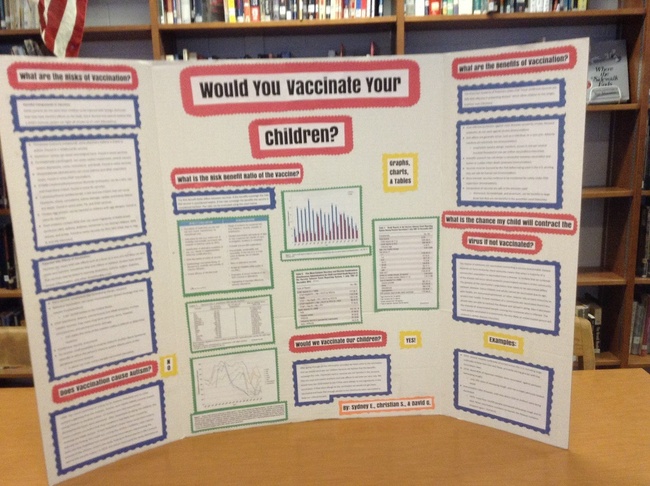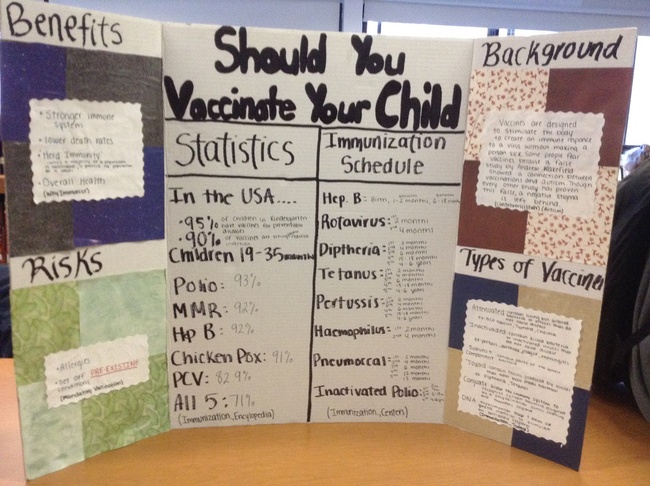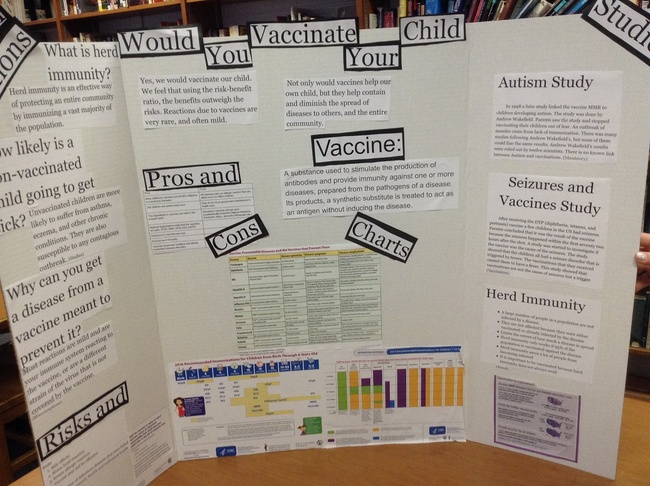Vaccine Dilemma
This template provides an approach for creating a STEM investigation that includes text-based inquiry to build student STEM literacy skills. It is populated with examples and resources to support your authoring. The template was created to support library media specialists and STEM teacher cohorts in year two of the School Librarians Advancing STEM Learning project, led by the Institute for the Study of Knowledge Management (ISKME) in partnership with Granite State University, New Hampshire, and funded by the Institute for Museum and Library Services (IMLS).
This template will be remixed by participants in the IMLS School Librarians Advancing STEM Learning project to build their own text-based STEM inquiry units. Other educators are invited to use this template. When remixing this template, be sure to remove all example language and add your own language in each section.
Part I:Title: Vaccine Dilemma
Part II: Background on LMS and Science Teacher Relationship:
This lesson was created by Library Media Specialist, Madeleine Wright; and Chemistry Teacher, Molly Horn. Madeleine strengths are locating and evaluating informational resources and information literacy instruction .Madeleine worked closely with Molly to ensure that the resources were pertinent to the overall project. Molly’s strengths incorporate how science works and making connections between scientific concepts and real life experiences. Molly holds her certification in Chemistry and has been a Teacher Leader at the high school for multiple years. Molly was able to utilize Madeleine’s resources and expertise to produce a project that allows students to apply scientific information to their lives.
Part III: Unit Description
This unit includes 6 lessons that culminate in students using scientific inquiry to create a group presentation discussing childhood vaccination. Using inquiry-focused reading, a video, and activities, students will learn how to formulate a conclusion based on scientific evidence. Students will research and choose additional texts to support their conclusions. When choosing additional sources, students are required to consider the questions: Is the information I am using good science? Is it a reliable source? The unit includes discussing the Wakefield Study as an example of poor scientific research and how poor research can spread inaccurate information. Students will need to include quoted information to support their conclusions and a MLA Works cited page
Students will watch a documentary, NOVA: Vaccines-Calling the Shots. Before viewing each section , students will read a supplementary essay. Students will answer and discuss the questions that accompany each video segment and essay. Using their discussions and answers, each group will devise their own set of two questions for each segment. They will answer and defend their conclusions using fact based research.
Part IV: Standards Addressed
HS-ETS1-1 Analyze a major global challenge to specify qualitative and quantitative criteria and constraints for solutions that account for societal needs and wants.
HS-ETS1-3. Evaluate a solution to a complex real-world problem based on prioritized criteria and trade-offs that account for a range of constraints, including cost, safety, reliability, and aesthetics as well as possible social, cultural, and environmental impacts.
CCSS Science Literacy Standards
CCSS.ELA-LITERACY. RST.11-12.9 Synthesize information from a range of sources (e.g., texts, experiments, simulations) into a coherent understanding of a process, phenomenon, or concept, resolving conflicting information when possible
Cite specific textual evidence to support analysis of science and technical texts, attending to important distinctions the author makes and to any gaps or inconsistencies in the account.
Integrate and evaluate multiple sources of information presented in diverse formats and media (e.g., quantitative data, video, multimedia) in order to address a question or solve a problem.
Part V: Unit Essential Question
If the government did not mandate vaccines, would you vaccinate your child? Why or Why not?
Use scientific facts to justify your answer.
Part VI: Goals for Using Inquiry
Students will demonstrate their ability to analyze and synthesize informational materials by using inquiry to develop their own questions regarding the risks and benefits of vaccinating their child.. The students will answer their questions in an online or print presentation. The library media specialist and the science teacher collaborated to select the anchor text and supporting materials. The science teacher will focus on the scientific aspects and the library media specialist will focus on research, literacy, and citation format. Both will offer support and guidance.
Part VII: Summative Assessment Description and Rubric
Discuss what you have learned and come up with 3 questions pertaining to: If the government did not mandate vaccines, would you vaccinate your child? Why” or Why not?
Questions should be well thought out and show understanding of the material covered:
________________________________________________________________________
________________________________________________________________________
________________________________________________________________________
Final Assessment:
Design and create a visual representation of your answer to “Would you vaccinate your child?” citing justification and illustrating points. Your three questions listed above should be answered in your visual. Visual may be in the form of a presentation board, an annotated slideshow or an infographic. Finished projects will be ‘presented’ on Tuesday, November 22 in the library.
Rubric for Vaccine Debate Presentation
Part VIII: Prior Knowledge Needed
How to locate and evaluate credible sources
notetaking and annotation skills
Collaboration skills
MLA citation format
Analytical Skills
Knowledge of basic chemical principles and formulas
(This description should describe both science content and literacy skills that are addressed.)
Part IX: Student Learning Objectives
(The breakdown of the unit into discrete units of both science content and literacy skills.)
Students will understand how vaccines work to protect against disease
Students will understand how vaccines are developed
Students will learn the mathematics behind herd immunity
Student will learn the chemistry behind vaccines
Students will learn how bad scientific research can have severe adverse social implications by studying the “Wakefield Study.”
Students will learn the importance of evaluating and selecting valid resources for their own research
Students will synthesize and organize their information.
Student will learn the ethics and importance of citing research material
Students will learn to correctly cite their resouces by using NoodleTools to create a MLA “Works Cited Page.”
Part X: Text Set Description
(Used by the teacher and media specialist as they analyze the purpose and goal of each text they provide to the students.)
Text Title & Hyperlink | Text Purpose (discuss complexity of the text along with its purpose/goal) | Text-dependent Questions (created by the teacher/librarian to help students analyze the text) | Accommodations for Diverse Learners |
Nova: Calling the Shots http://nhptv.pbslearningmedia.org/resource/nvvs-sci-autism/autism-vaccines/ Before viewing each segment, students will read a background essay | This is our anchor text designed to help students think about the role of government and the science behind vaccines The entire video is about 60 minutes. It is broken down into four 20 minute segments Librarian will go review vocabulary with students And help students with sections they do not understand. | Librarian and science teacher will review vocabulary, read out loud, and provide extra help for students with sections they do not understand. | |
Supporting Essay Background Essay for Immunity and Vaccines The essay and video are located: http://nhptv.pbslearningmedia.org/resource/nvvs-sci-spox/the-smallpox-vaccine/ | The essay has a ATOS of 10 Students will gain an understanding of the body’s immune system and how vaccines work to build immunity against disease |
| Librarian and science teacher will review vocabulary, read out loud, and provide extra help for students with sections they do not understand. |
Nova Video: Calling the Shots-The Smallpox Vaccine http://nhptv.pbslearningmedia.org/resource/nvvs-sci-spox/the-smallpox-vaccine/ . | Students will learn the history of how the smallpox vaccine was developed. |
| Librarian and science teacher will review vocabulary, read out loud, and provide extra help for students with sections they do not understand. |
What is Herd Immunity? http://www.pbs.org/wgbh/nova/body/herd-immunity.html Nova Video: Calling the Shots-Herd Immunity http://nhptv.pbslearningmedia.org/resource/nvvs-sci-herdimmune/herd-immunity/ | Students will learn the science behind herd immunity and what can happen when herd immunity is compromised This essay has a ATOS level of 11.5 |
| .Librarian and science teacher will review vocabulary, read out loud, and provide extra help for students with sections they do not understand. |
Supporting essay and video for Autism and vaccines http://nhptv.pbslearningmedia.org/resource/nvvs-sci-autism/autism-vaccines/ | The essay ha a ATOS of 10 |
| Librarian and science teacher will review vocabulary, read out loud, and provide extra help for students with sections they do not understand. |
Supporting Text #2 |
Part XI: Suggested Lesson Breakdown/Pacing
Day | Student Learning Objectives | Aligned Student Learning Task & Suggested Timing | Formative Assessment | Important Accommodations |
Day 1: 80 minute block | Students will learn how vaccines work with the immune system . | (10 min) .Introduce the project and the project rubric (15 min) Students will work with their group on a pre learning vocabulary assessment. The following are included: vaccine, inoculation, booster, vaccine schedule, virus, pathogen, antibodies, polio, measles, whooping cough, autism, airborne disease, immunization, epidemic, and salk vaccine We will review as a class (10 min) Read Nova essay:Vaccines and Immunity (15 min) Watch Nova video: Calling the Shots: Vaccines and Immunity (0 - 15:04 minutes) (10 min) Each group will discuss and answer, the following;
| Each students will provide 2 annotations for the article: Vaccines and Immunity Student groups will turn in the written responses to discussion questions | Teacher / librarian will circulate among groups and provide group and one-on-one assistance Teacher/LMS will read the article out loud, if needed. |
Day 2 80 min. block | Students will learn the history and controversies of the smallpox vaccine. This will help them relate to today’s controversies. Students will learn about vaccine additives and how vaccines are currently made. They will focus on the additive thermoseal | (10 min). Review and discuss questions from day 1. (5 min) Watch Nova Video: Calling the Shots-The Smallpox Vaccine:http://nhptv.pbslearningmedia.org/resource/nvvs-sci-spox/the-smallpox-vaccine/ (15:04 - 18:43) (15 min) Groups will answer and discuss the following:
(10 min) Review and discuss questions and answers (20 min)? What additives are in a vaccine? Groups will study vaccine additives focusing on the thimerosal controversy. Read CDC fact Sheet http://www.cdc.gov/vaccines/vac-gen/additives.htm Read CDC article on Thimerosal Thimerosal:http://www.cdc.gov/vaccinesafety/Concerns/thimerosal/index.html 10 min. http://www.pbs.org/wgbh/nova/body/making-vaccines.html While doing the interactive activity Making a Vaccine student will answer the following:
| Student groups will turn in the written responses to discussion questions and interactive activity questions Students will provide two annotations for CDC article on Thimerosal | Teacher /librarian will circulate among groups and provide group and one-on-one assistance |
Day 3 80 min. | Students will learn how herd immunity protects society | (10 min.) Review and discuss questions and activities from day 2. (15 min) Students will read What is Herd Immunity? http://www.pbs.org/wgbh/nova/body/herd-immunity.html (10 Min) Watch Nova Video: Calling the Shots-Herd Immunity (18:43 - 26:45) .http://nhptv.pbslearningmedia.org/resource/nvvs-sci-herdimmune/herd-immunity/ (15 min) Groups will discuss and answer the following questions:
| Each student will provide two annotations for the Article: What is herd immunity? After reading article: What is Herd Immunity? And watching the NOVA Video: Calling the shots-Herd Immunity,students will answer the following questions: | |
Day 4 80 min. | Students will learn how bad scientific research can lead to misinformation and have social consequences | 10 min. (review and discuss herd immunity) (15 min.) Read and provide two annotations for NOVA article: Autism and Vaccines (15 min.) Watch supporting video: NOVA: Calling the Shots: Autism and Vaccines. (26:45 - 41:15 http://nhptv.pbslearningmedia.org/resource/nvvs-sci-autism/autism-vaccines Groups will discuss and answer the following questions: 1. What was wrong with the “Wakefield Study.” 2. What were the social consequences? (20 Min.) The series is finished. Student groups will discuss what they have learned to create three of their own questions related to the role of government in mandating vaccination. They will use their own questions to research and answer for their presentation. | Teacher /librarian will circulate among groups and provide group and one-on-one assistance. | |
| Day 5 80 min. | Students will review citation format and research techniques. They will begin their projects | ( 45 min.) review citation format and research sources and techniques (35 min.) begin project | ||
| Day 6 80 min. | Work on Project | (80 Min ) Library Research and project work | Librarian and Science teacher circulate among groups and provide assistance with research, resources, and project work | |
| Day 7 80 min. | Work on Project | (80 Min) Library Research and Project Work | Librarian and Science teacher circulate among groups and provide assistance with research, resources and project work | |
| Day 8 80 min. | Students set up and present their projects and answer questions |
Formative Assessment for Group Questions
Part XII: Student Work
Final Projects

Final Project

Final Project

Final Project
Part XIII: Teacher and LMS Reflection on the Implementation of the Lesson